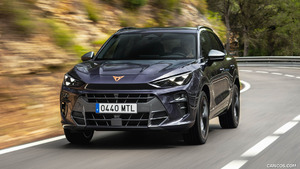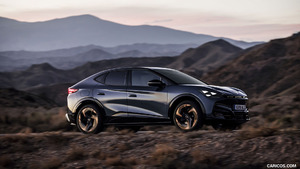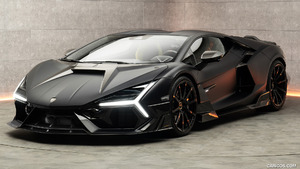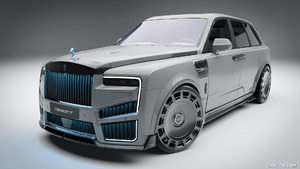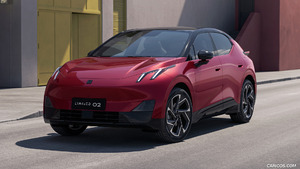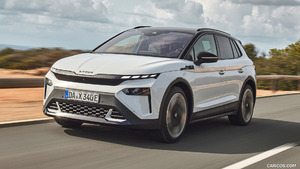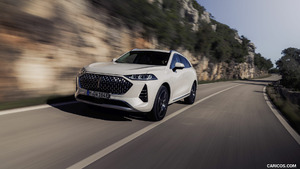2012 Toyota Camry
TORRANCE, Calif. – Toyota introduced today the all-new, seventh-generation Camry, America’s best-selling car for nine years running and 13 of the past 14 years. The 2012 Camry debuts a bold, sophisticated new design with a more spacious interior, improved driving dynamics and an even quieter ride than before. With class leading safety, fuel economy and multi-media technology added in, the end result is the best Camry ever made. Introduced in 1983, the Toyota Camry would later establish the template for the modern midsize sedan, setting benchmarks for Quality, Dependability and Reliability, along with a comfortable, quiet ride. Since that time, Toyota has sold more than 15 million Camry models worldwide.
“The all-new 2012 Camry blends an evolution of the car’s values – such as comfort, efficiency, reliability and safety – with a more appealing design and engaging driving experience,” said Bob Carter, Toyota Division group vice president and general manager. “Competition in the midsize sedan segment is the strongest it’s ever been, and the all-new Camry is designed to maintain its long-standing leadership while also broadening its appeal.”
The Toyota Camry again offers three powertrain choices, all of which have been enhanced for 2012 to provide better fuel economy and more responsive performance. All Camry models with the revised 2.5-liter four-cylinder engine now offer 178 horsepower, an increase of nine hp, and 170 lb.-ft. of peak torque. EPA-estimated fuel economy figures are 25 mpg city/35 highway, and the 28 mpg combined is two more than the previous generation Camry. The 2.5-liter engine employs Dual VVT-i (Dual Variable Valve Timing-intelligent), which controls valve timing on both the intake and exhaust camshafts for optimal performance and efficiency at all engine speeds. The Acoustic Control Induction System (ACIS) helps optimize torque over a broad engine speed range.
Performance and Efficiency
The DOHC 3.5-liter V6, available in the SE and XLE grades, delivers 268 horsepower at 6,200 rpm and 248 lb.-ft. of peak torque at 4,700 rpm. Enhancements to this engine boost its fuel economy to projected EPA-estimated ratings of 21 mpg city/30 mpg highway, the best for any current V6 midsize sedan.
The V6 uses chain-driven camshafts and Dual Variable Valve Timing with intelligence (Dual VVT-i). To improve efficiency, the V6 features a new, lower oil viscosity and an automatic transmission fluid warmer that brings the transmission to operating temperature more quickly in cold weather. Higher final drive-gear ratios also contribute to better fuel economy in the new Camry models.
The gas-engine LE, XLE and SE models come equipped exclusively with a six-speed automatic transmission that offers a sequential manual shift mode using the console shifter. Intelligent control adapts shifting strategy in response to driver input, with fast kick-down. In addition, the Camry SE exclusively offers a “D range” sequential shifting, which allows manual shifting with the new steering wheel paddle shifters even when the console shifter is in the “D” mode. Also exclusive to the Camry SE, the automatic transmission features faster shift times when in “S” mode and downshift blipping control emphasizes a sense of sportiness.
All-New Camry Hybrid Sets New Standard for Mid-size Hybrid Sedans
The all-new Camry Hybrid debuts a highly revised version of the brand’s Hybrid Synergy Drive powertrain, including a new 2.5-liter four-cylinder engine. The 2012 Camry Hybrid LE, with EPA-estimated 43 mpg city/39 mpg highway/41 mpg combined, yields a more-than-30 percent boost in fuel economy in the EPA city and combined driving cycles, compared to the previous generation, thanks largely to the new hybrid powertrain, but also due to lighter vehicle weight and optimized aerodynamics.
Through its unique transaxle, the Hybrid Synergy Drive system combines output from the four-cylinder engine with a small high-torque electric motor. The system produces a combined 200 horsepower and varies power between the gas engine and electric motor, or combines both, as needed.
The new 2.5-liter engine, like the 2.4-liter it replaces, uses the Atkinson cycle (delayed intake-valve closing for an expansion ratio greater than compression ratio) to achieve maximum efficiency. The Variable Valve Timing with intelligence (VVT-i) system on the intake camshaft enhances torque, which is greater than with the previous engine. An electric water pump, a roller-rocker type valvetrain and a variable-output oil pump help to reduce internal friction, boosting economy.
A new water-cooled exhaust gas recirculation (EGR) system helps to ensure the lowest possible emissions at all vehicle speeds and helps increase fuel efficiency. By cooling and controlling exhaust gas injected into each cylinder, the system eliminates the need to richen the air-fuel mixture to control cylinder temperatures.
The 2012 Camry Hybrid meets AT-PZEV (Advanced Technology Partial-credit Zero Emissions Vehicle) standards. New sound absorbing materials in the engine compartment, along with more linear control over engine speed, give the 2012 Camry Hybrid a more pleasing sound under acceleration.
Because there are situations in which the gas engine in the Camry Hybrid shuts off, air conditioning and power steering systems are driven electrically. New efficiency measures in the Hybrid Synergy Drive system include reducing internal losses in the transaxle, improving motor-voltage control, and optimizing the regenerative braking. The proven nickel-metal-hydride battery, located in the luggage compartment behind the rear seats, now features enhanced air-cooling. Its more compact size, along with moving the DC/DC converter to the engine compartment, results in a trunk that is 2.1-cubic feet larger than in the previous-generation Camry Hybrid.
Lighter overall vehicle weight also contributes to better performance and fuel economy. Its 7.6-second zero-to-60 acceleration time places the Camry Hybrid between the four-cylinder and V6 models. Lower rolling resistance tires, available for the first time in 17-inch size, also help boost fuel economy.
New for the 2012 Camry Hybrid, an EV Drive mode allows the driver to operate the car on the electric motor alone for up to 1.6 miles at lower speeds (below approximately 25 mph). The EV indicator illuminates when the vehicle is being propelled solely by the electric motor.
As on the previous Camry Hybrid, ECO mode optimizes throttle response and air conditioning output to prioritize maximum fuel economy. A Hybrid-exclusive instrument cluster with Hybrid System Indicator and fuel consumption indicator helps the driver to operate the car as economically as possible.
Instantaneous fuel economy is shown with LEDs (light emitting diodes) around the outside of the average fuel economy gauge. The car’s Multi-Information display graphically shows fuel economy in real time and can also show energy flow, and cruising range information.
As before, applying the brake converts the motor to a generator that captures the kinetic energy from the still-spinning vehicle wheels, storing it in the hybrid battery pack. Putting the shifter into “B” uses regenerative braking as a form of engine braking for enhanced control on steep descents. New hill-start assist control helps prevent the vehicle from rolling backward when starting off on an incline when the brake pedal is released.
Exclusive exterior and interior design touches and badging differentiate the 2012 Camry Hybrid from other Camry models. Inside, Hybrid-exclusive trim is found on the instrument panel and door switch bases, upper console panels and shift knob. The Camry Hybrid also features its own exclusive seat fabric in ivory or light gray. An exclusive leather and Ultrasuede is also available. A three-dial Optitron gauge panel with chrome-accented outer rings provides a luxurious appearance.
Grade Strategy
The all-new Camry and Camry Hybrid will offer six different model grades to choose from. Camry will be available in the entry-level L, value-driven LE, premium XLE and sporty SE grades. The XLE and SE are available with four-cylinder or V6 engines. The Camry Hybrid is offered in LE and XLE grades.
Exterior Design
The 2012 Camry employs an elegantly simple but modern form, emphasizing a wider, lower stance than previous models. The design conveys an “architectural statement” through crisp, precise character lines, while a more strongly curved door cross-section and more defined rocker panel molding (chrome accented on LE and XLE) give the Camry a more expressive appearance.
Headlights show a more dynamic shape, with a pronounced curvature of the main-beam unit merging into the bumper cover. Fog lights are standard on the XLE and SE grades. The rear lamp clusters wrap tightly into the body sides, with their top sections extending into the trunk panel.
The Camry LE and XLE feature additional exterior chrome trim, and the SE grade debuts its own lower-body design and exclusive fine-mesh upper grille section. The SE also features three-part lower grille section housing fog lamps, along with black sport trim headlamp bezels. The more prominent rocker panel moldings on the SE cleanly link to integrated front and rear underbody spoilers, emphasizing width, and the trunk lid carries an integrated spoiler.
Accentuating the new body design are four new colors. Two of the colors (Attitude Black Metallic and Clearwater Blue) are all-new to Toyota in the U.S. Attitude Black Metallic blends in a bright blue pigment for an intriguing take on traditional jet black; Clearwater Blue incorporates a silver metallic pigment to lend this hue a glassy, water-like finish.
Interior Design
While featuring nearly the same external dimensions as the previous generation, the 2012 Camry offers a more inviting and spacious interior. A new dashboard design, modified seat locations, redesigned seats and “lean” door, pillar and headliner trim all combine to add both real space and greater perceptual spaciousness while also enhancing outward visibility. Repositioning the driver’s seat and the standard tilt/telescoping steering wheel (tilt has increased 33 percent for greater driver comfort) also aid forward visibility and enhance the driver’s positioning.
The accelerator pedal and front seats were moved forward, and the rear-seat hip point was positioned rearward, increasing the couple distance by 0.6-inch; together with reshaped front seatbacks help increase rear-knee room by 1.8-inch. The redesigned center console and front edge of the rear-seat cushion increase rear middle seat legroom by two inches.
Not as obvious are the many areas where Camry designers reshaped interior trim to increase the feeling of spaciousness, including the A- and B-pillars, headliner over the rear seat and door trim. In most vehicles, space is left between the structure and the trim to yield a “clean” surface. Using a lean-car design approach, the trim more closely follows the structure beneath it. The result is added space that contributes much more to a feeling of comfort than the gains in mere millimeters might suggest.
Three-dimensional construction and contrasting-material textures give the new instrument panel a feeling of depth, while the shapes themselves contribute to a more spacious cabin and improved forward sightlines. The prominently curved center cluster appears to float over the instrument panel, reducing its visual mass. Soft textures used on the upper instrument panel, upper door trim, door armrests and center console armrest contribute to greater comfort in the Camry. Stitching on the instrument panel soft padding and matching stitching-look trim elsewhere helps to create a sense of luxury. Aluminum-color and chrome trim are used judiciously.
The Camry LE and XLE grades feature either ivory or gray seating color; the Camry SE features unique upholstery in black-on-black or black-on-gray. Newly designed front-seat frames, higher seatbacks and longer seat cushions enhance comfort. The height adjustment on the driver’s seat offers nearly a half inch greater range than before (total travel is 2.4 inches). The SE’s sporty front seats provide thicker side bolsters, and the exclusive three-spoke leather-wrapped steering wheel offers paddle-shift control for the six-speed automatic transmission.
For 2012, the Camry offers four seat-covering materials: fabric in the LE and XLE; fabric with SofTex in the SE, standard leather trim on the XLE V6 (optional in the XLE four-cylinder), and Ultrasuede® with leather available for the SE and XLE Hybrid. Heated seats are standard on the XLE V6 and are available for SE, XLE four-cylinder and Hybrid with variable temperature control.
The new Camry provides the added functionality demanded by consumers today, yet keeps its controls straightforward and intuitive to use. Control knobs impart a high-precision feel when used. Special attention was paid to function and comfort with the center console design. Soft kneepads on both sides add comfort for the driver and passenger; the front section offers a 12V accessory connector and an easy-to-access USB/input jack port for connecting iPods and other media devices. A sliding rear console door – rather than the more traditional flip-up design – enables easier access from either front seat. Two steering wheel designs, with integrated audio and Bluetooth® controls, are featured: a four-spoke for LE; a leather-wrapped four-spoke for XLE; and a sporty three-spoke, leather-wrapped wheel for the SE.
All grades now feature a standard 60/40 split folding rear seatback to expand cargo capacity. The seats can be lowered by a remote release from the trunk area. Rear-seat side airbags are standard across the line, and an armrest with cup holders adds comfort and convenience.
Advanced Connectivity
Seamlessly integrated into the Camry are state-of-the-art electronics and enhanced connectivity features. A Bluetooth wireless connection for compatible hands-free phone calls is standard, now improved by an available automatic phone book transfer function. Also standard is a USB port that allows playing of music and video from portable audio devices, using the vehicle sound system and available in-dash display screen, including full iPod integration.
The standard audio system on LE, XLE and SE has a 6.1-inch screen and six speakers. The screen also displays the energy monitor and fuel consumption data, and functions as the monitor for the available integrated back-up camera (SE and XLE only) and the Display Audio System. The screen also offers a new value-driven navigation system and serves as a portal for Entune, Toyota’s innovative new multimedia system. An available HD Radio system enables CD sound quality from digital FM broadcasts, and has features that maximize analog and AM broadcast sound quality. The system will include HD Radio with iTunes tagging for future purchase and SiriusXM Satellite Radio™.
The top-of-the-line audio is equipped with a new seven-inch Premium HDD Navigation system with Entune™ and JBL. This system offers a new split-screen feature that allows for simultaneously displaying navigation and audio information.
Camry also offers the new JBL GreenEdge™ audio system that combines an eight-channel amplifier and door-mounted “acoustic lens” speakers, to provide a high-quality sound. The GreenEdge amplifier achieves a 66-percent reduction in overall mass and a 50-percent enhancement in sound efficiency. The GreenEdge speakers produce a higher output of sound with the same power or less consumption of conventional models.
Entune Multimedia System
Camry will be one of the first Toyotas to offer the Entune multimedia system. For the first time ever in a Toyota automobile, this new system leverages the mobile smartphone to provide a richer in-vehicle experience with fully integrated access to navigation, entertainment and information services.
Toyota Entune debuts the first-ever support for engaging mobile apps, such as Bing, OpenTable, and movietickets.com, along with accessing useful travel-related services, such as live weather, traffic, fuel information (location and price), stocks, and sports. Toyota Entune brings the largest selection of music options available to a vehicle, including iHeartRadio’s 750+ stations, and Pandora’s personalized music service.
The audio systems combined with Entune feature a best-in-class, advanced conversational voice recognition system that helps the driver to stay focused on the road by eliminating the need to memorize thousands of voice commands. The system will also allow for audio read-back and replay capabilities for text messages, with the ability to respond by pre-set “Quick Reply Messages” such as: “I’m driving and will reply later.”
A New Benchmark for Midsize Sedan Quietness
Long lauded as a benchmark for ride smoothness and quietness in the midsize segment, the all-new Camry resets the standard by taking both attributes to an even higher level of refinement. To reduce noise throughout the entire cabin, focus was placed on suppressing noises that stand out. As powertrains have become more refined and quieter, wind noise and road noise have tended to become more noticeable to drivers and passengers. A low noise reading (in decibels) does not always equate to a subjectively quiet interior. Vehicle occupants’ perception of quietness also depends on the type and frequency of the sound.
It was determined where such noticeable sounds enter the cabin, and additional insulation was placed in those areas. New sound absorbing materials silence any noise that manages to penetrate the interior. In particular, engineers focused on suppressing noises that are near the frequencies of human speech to provide an environment that is more comfortable for conversation.
Measures that focus on reducing wind noise include stronger door and rocker area seals; optimized placement of sound insulating materials; foam applied in the roof, pillars and door openings; acoustic glass used for the V6 and Hybrid model’s windshield; and special bracing of cowl intake louvers.
The dashboard structure and assembly, one of the most complex areas in modern cars, was thoroughly optimized to prevent noise intrusion. It can also be a source of noise intrusion. The structure employs a new cross member and center brace, along with sandwiched sheet steel to suppress resonance and reduce vibration. With the sandwiched steel, asphalt foam is used to absorb vibration energy while increasing sound blocking effectiveness.
A dash outer silencer uses an air layer between the dash panel and sound absorbing felt. An inner silencing layer uses soft and hard felts to block a wide range of low-to-high frequencies. Damping-coating thickness and application areas have been optimized for reduced floor-panel vibration and noise penetration through the floor, and a new type of carpet helps eliminates noise. Silencer panels installed in the rear-wheel housings, and new sound-absorbing materials added to the trunk’s interior side trim further reduce road noise from the tires and wheel housings.
Exceptional Handling and Ride
A more rigid body structure, revised front suspension, redesigned rear suspension and aerodynamics all help to imbue the new Camry with greater straight-line stability and crisper steering response, while also enhancing overall ride comfort. Handling stability, more than just conveying a sense of driving enjoyment, also greatly influences the driver’s feeling of security.
The 2012 Camry body structure uses a greater amount of high tensile steel (440 Mpa or higher) than before and even stronger high tensile strength sheet steel (590 Mpa or higher), resulting in a stronger but lighter body than the previous model. A flared design on the doors and fenders enables use of slimmer but stronger construction. High tensile aluminum bumper supports are lighter yet stronger than before. Newly developed plastic for the bumper covers and cowl louvers reduces weight as well.
The stiffened cowl section increases suspension-area rigidity, suppressing twist. The front-suspension towers are directly connected through the cowl to increase rigidity, and the attachment method and reinforcement braces have been strengthened. The all-new rear underbody and rear subframe increase lateral force control and torsional rigidity.
The McPherson-strut front suspension now uses inversely wound coil springs that enhance straight-line stability. Shock-absorber damping and stabilizer-bar thickness have been optimized as well. The rear suspension retains the proven dual-link strut configuration of the previous model but has been redesigned with new geometry (increased toe-in during cornering and braking) and retuned components to enhance cornering stability. Coil springs, bushings, stabilizer-bar and shock-absorber damping have all been revised.
Rear-combination lamps and side-view mirrors on the 2012 Camry incorporate aero stabilizing fins, inspired by Formula One racing technology, that create air vortexes on the body sides to stabilize the body and contribute to handling stability. Underbody aerodynamic elements regulate airflow under the vehicle, also contributing to ride smoothness.
The Camry SE model features specific suspension components and tuning, including exclusive steering knuckles and lighter, stiffer lower front control arms. The front and rear springs are exclusive to this model, and the shock absorbers feature internal rebound springs for greater cornering roll resistance. The rear suspension No. 1 control arm uses a pillow-ball bushing to further enhance handling agility.
All new Camry models will be the first to feature Toyota’s latest electric power steering (EPS) control system, which will offer more flexibility to steering-feel tuning. The system regulates power-assist response based on vehicle speed, and for the first time steering-input rate. The vehicle-speed sensing feature will provide light effort during low speeds, changing to moderate effort during higher speeds.
The SE grade will feature a power-assist ratio that provides a more sporty feeling than the LE and XLE. Also, electricity is only consumed when assist power is necessary, helping to improve fuel economy. Electric power steering is also more environment-friendly, as it does not require hydraulic fluid.
All Camry grades feature newly developed all-season tires designed for an optimal balance of fuel economy, handling, quietness, ride comfort and braking performance. The LE grade features standard 16-inch wheels; the SE comes standard with five-spoke 17-inch alloy wheels and the V6 SE offers the first 18-inch alloy wheels on a Camry. The latter feature is a unique twist-spoke design with 225/45R18 all-season tires. Camry SE models will also include tires that have more grip. The Camry XLE comes standard with 17-inch alloy wheels featuring an elegant 10-spoke design.
Safety and Security
All 2012 Camry models are equipped with 10 standard airbags: dual-stage advanced SRS front airbags, front and rear seat-mounted side airbags, side curtain airbags and a driver’s and front passenger’s knee airbag. The front-passenger’s knee airbag and rear-seat side airbags are new to Camry.
The Camry’s body structure is designed to help absorb collision-impact forces and help minimize impact deformation to the passenger cabin. High-strength steel is used for B-pillar and rocker-panel reinforcements to help manage overall body deformation in the event of certain side collisions. The seat frames also are designed to help absorb side collision loads. The inner-hood structure and front-edge construction are designed to help reduce pedestrian injuries in a collision.
Like all Toyota models, the Camry will feature Toyota’s Star Safety System™ standard, which includes Vehicle Stability Control (VSC), Traction Control (TRAC), Anti-lock Braking System (ABS), Electronic Brake-force Distribution (EBD) and Brake Assist. It also features the standard Smart Stop Technology brake-override system. An electronic tire pressure monitoring system is standard equipment.
Another available safety system, Safety Connect, can access a call center with a live operator who can dispatch police and emergency vehicles. The system combines automatic collision notification and a stolen vehicle locator feature, which can track the location of the stolen vehicle via GPS and help guide police to recover it.
The new available Blind Spot Monitor uses sub-millimeter wave radar to detect vehicles in the driver’s blind spots. When the system detects a vehicle in the adjacent lane, it alerts the driver using indicators on the side mirrors. If the turn signal is on when the there is a vehicle in the blind spot of the driver’s intended lane, the indicator on the corresponding mirror will flash. The driver can switch off the system, if desired.
In vehicles equipped with one of the display audio systems and backup camera, when the vehicle is shifted into Reverse, the audio display will show the image of what the camera captures, along with an overlay of positioning lines representing the parking space and distance to obstacles.
Peace of Mind Warranty Protection
Toyota’s 36-month/36,000 mile basic new-vehicle warranty applies to all components other than normal wear and maintenance items. Additional 60-month warranties cover the powertrain for 60,000 miles and against corrosion with no mileage limitation. The hybrid-related components, including the HV battery, battery control module, hybrid control module and inverter with converter, are covered for eight years/100,000 miles.
The Camry will also come standard with Toyota Care, a complimentary plan covering normal factory-scheduled maintenance and 24-hour roadside assistance for two years or 25,000 miles, whichever comes first.





